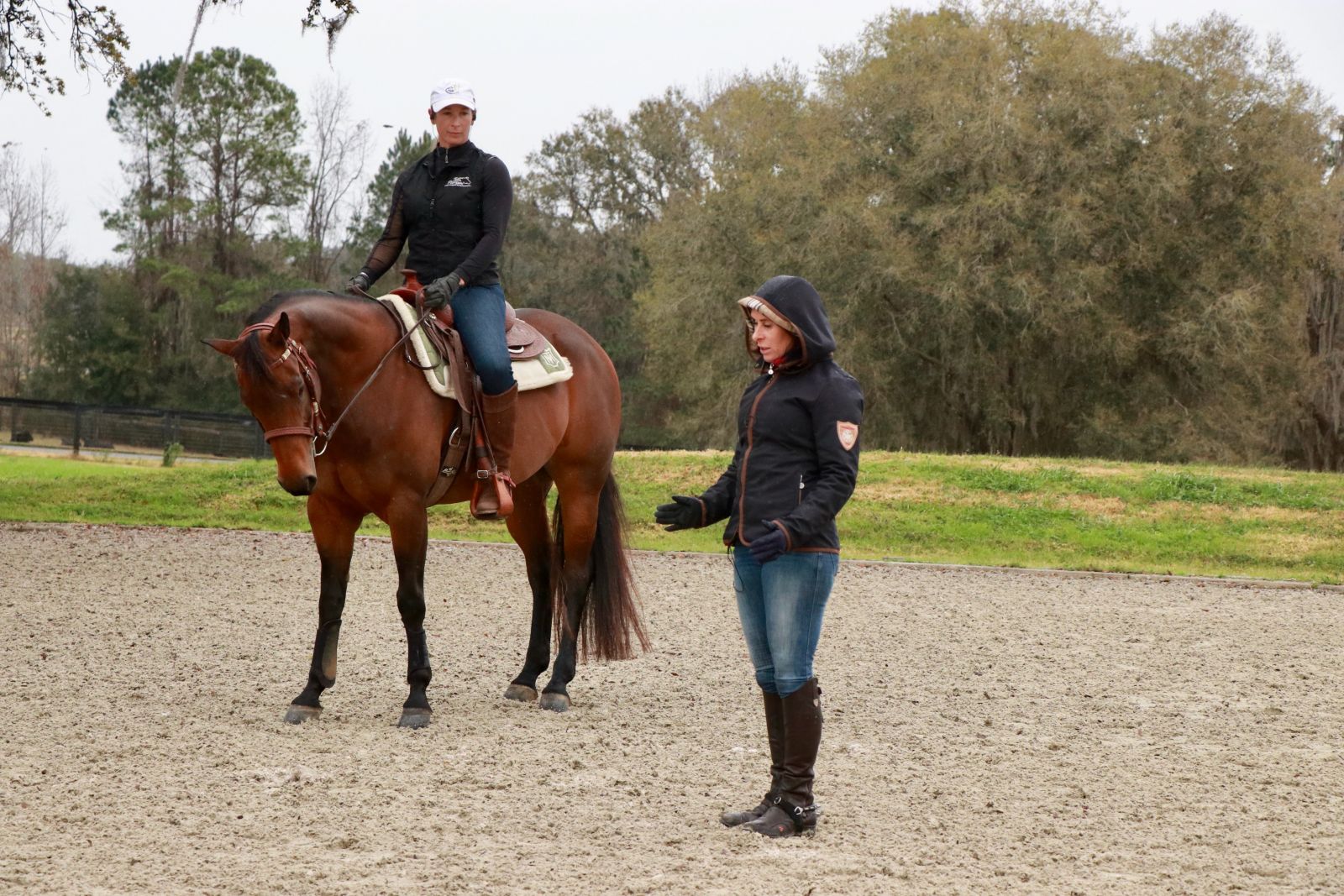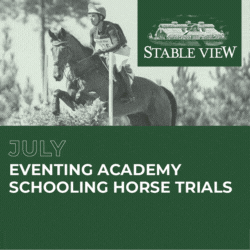Florida: the land of watercolor sunsets, beach-side show jumping, and, of course, the infamous Florida Man phenomenon. It’s also the state that transformed reiner Rachel Ory’s riding career forever.
Rachel has been starting colts alongside reining trainer Tom Pierson since 2008. Together, Rachel and Tom traveled between Traverse City, MI and Scottsdale, AZ in the winter starting everything from warmbloods to quarter horses, until one day in 2015 when they had the opportunity to move to Florida. That decision had Rachel trading in her Western saddle for a dressage saddle.

Rachel Ory & Veronica riding a sliding stop. Photo by National Sports Broadcasting.
“Coming to Florida opened up a whole new world of dressage. I had done some western dressage on my own horse, but living in Ocala has allowed me to immerse myself in the art. I study and ride with top class trainers and horsemen on a regular basis. After a few years, I was able to add dressage and western dressage to what I can offer as a trainer,” Rachel said.
Western dressage isn’t as different from pure dressage as you might think. According to Rachel, the biggest difference is that the tests are set up with the Western horse in mind. “Generally if you’re riding a Western-bred horse, they’re going to tend to have a little more set to them and really be able to squat on their haunches,” Rachel said. “So, the western dressage tests are set up to showcase movements like the lope and pirouette a little earlier in the levels than what you would see in dressage.”
There are a few other unique variations in the movements themselves. “What would be your walk pirouette turns into more of a pivot for the Western dressage. It’s still with forward intention, but they are allowed to kind of plant that inside hind and pivot like your traditional Western horse would do,” said Rachel. “Western dressage can be a little more relaxed and laid back because you’re not having to hold that contact so much. We ride on light contact with a soft connection. It’s not a loose rein, but it’s a little softer connection between the hand and the horse.”
After moving to Florida, Rachel and Tom began operating out of Mardanza Farms in Marion County, a unique 600 acre property that brings together great horsemen and women from multiple different disciplines. Home to Valerie Pride of Blue Clover Eventing, Gabby Dickerson Eventing, Last Frontier Farm, as well as several other smaller trainers, Mardanza Farms is an epicenter for top trainers from a wide range of disciplines, including reining and eventing. While Sharon White operates Last Frontier Farm out of the facility, Bettina Hoy has also been flying over for the last few years.

Rachel Ory and Veronica with Bettina Hoy, Sharon White and Tom Pierson at Mardanza Farms. Photo Credit: Kelly Mastine
According to Rachel, Mardanza Farms is home to a close knit community. “We all support each other. Sometimes we ride together and once in a while we’ll all meet for dinner with the owners of the farm who are so encouraging to us all. For those of us who keep coming back year after year, we’ve become like family.”
And it’s not just the eventers who help Rachel with her training, the opposite is also true. “Tom and I have helped Sharon with some of her young horses and she has ridden some of our reiners just for fun, just to get on and see what it feels like. And it’s always fun to share ideas, since we all are open to new ways of looking at things,” said Rachel. “Bettina got on one of our reining horses too while she was here, just to try it. Why not?”

Training horses is a universal language. Photo by Sally Spickard.
As Rachel began dipping a toe in the waters of first Western dressage and then, later on, pure dressage, she enlisted help from Sharon and Bettina in transforming her nine-year-old quarter horse mare, Veronica (beautiful name, by the way), into a dressage horse. Sharon helped Rachel with grid work exercises, while Bettina focused on teaching Veronica to push forward into the bridle, which is the opposite of how most Western horses are taught to ride.
Sharon’s grids had Rachel working on her adjustability. “Working with Sharon White has been a big plus to add some variety into my program. I love learning new ways to use cavalettis and ground poles. I find it benefits my horses to present this test of their adjustability and balance in a way that creates visual interest for them,” Rachel said.
Bettina tackled the challenge of teaching Veronica to maintain connection while creating greater impulsion. She assigned Rachel exercises like riding a small circle into shoulder-in in collected trot, then lengthening across the diagonal. She encouraged them to go more actively, developing the push of the hindquarters, and creating more energy traveling over the top line to the bit. “It took a lot of effort to get the mare seeking the contact and wanting to go forward into the contact,” Rachel said. “There would be moments where I could feel Veronica get locked up or tense through her back and Bettina was just really good at seeing the little details and talking me through how to unlock her without dropping the contact.”
Working with Sharon and Bettina paid off. “Once our dressage felt really good, we were able to pursue our silver medal and do the Prix St. George at WEC with the real life dressage horses, which was a bit daunting, as there were some really big, fancy movers there. I’m glad that we did though, because you don’t see a whole lot of quarter horses in that ring. Plus, we learned a lot from the whole experience,” Rachel said. “Veronica doesn’t have the big movements like the warmbloods do, but my goodness, she tries her heart out. She’s such an amazing horse. So willing.”

Rachel Ory and Veronica in their USDF Silver Medal test at WEC. Photo by Q2 Photography.
Rachel’s biggest takeaway from her adventures in dressage, and in training with eventers, is that great horsemanship isn’t discipline-specific. “Good riding is good riding. We can learn something from everyone, especially if they are at the top of their game. Sharon and Bettina most certainly are. I have a lot of respect for what they do, and I’m so grateful that I’ve had the opportunity to be able to work with them,” Rachel said.
True to her roots as a colt starter, Rachel also says that cross-training has benefits for your horse’s resume, too. “The more variety that you can add into your program, the more well-rounded your horse is going to be and the more broke they’re going to be,” said Rachel. “Everything complements each other. In 2021, Veronica and I did a freestyle reining competition at the World Equestrian Center, and our routine incorporated the dressage movements that we had been working on, along with the required stops and spins for the reining. It was magical to be able to showcase the reining maneuvers next to the dressage movements all on the same horse in the same ride. We marked a 221 and were reserve champions.”
“I’m just trying to find what’s healthy and best for the horses. Presenting them with a variety of exercises and not dwelling too much on any one thing seems best for them, even if they are specialized in one discipline,” said Rachel.
Rachel and Veronica aren’t hanging up their rowel spurs just yet. Next, the pair is going to return to the Western dressage ring to compete in the Western Dressage Association World Championship Show this fall. “It was asking a lot of her to help me secure the USDF Silver Medal. For her to now come back and do Western dressage– that will feel a little bit like a break for her in some ways,” said Rachel. “She worked so hard, and I want to respect her body so that hopefully she’ll remain happy and healthy for years to come.”
At the end of the day, Rachel and Veronica’s story is a great reminder that no matter what tack we wear, all equestrians have one thing in common: we just want to do what’s best for our horses.
This article was sponsored by World Equestrian Brands. When I asked Rachel what her favorite product was, she was hard-pressed to choose just one. “Oh my gosh, I have to pick one?” Rachel said, laughing. “The Equilibrium splint boots are so breathable and nice. And they work almost with a little bit of compression. So I use those everyday on Veronica. The Vespucci bridles are amazing. And then the Mattes sheepskin pads. Oh my gosh. I love them.”




















